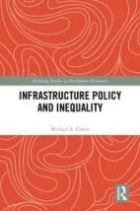


The definition of infrastructure itself has to be expanded beyond cement and pipes to include infrastructure as process, infrastructure as knowledge and information, infrastructure as institutions, infrastructure as people, infrastructure as nature, and infrastructure as intention. Without each of these definitions there is no hope for improving human well-being.
This is the central conclusion of a new book by Michael Cohen as he reflects on his 50-year engagement with urban infrastructure and other key urban issues. This included 27 years at the World Bank, helping develop new urban policies (including upgrading informal settlements and new house sites and services) and a much increased loan programme. In the 1990s, unhappy with how the Bank had become “… increasingly and visibly subordinated to the IMF”, he joined York University and then The New School to establish a new graduate programme in international affairs.
Thus, there are few who can rival the depth and detail in his new book Infrastructure Policy and Inequality.
This book has ten chapters. The first two explain how infrastructure can contribute to the achievements of socio-economic goals with chapters 3 to 7 providing a history of urban discussions and engagements with development assistance:
These are followed by chapters on aid agencies and on how infrastructure can be used to reduce urban poverty. As stated in the first paragraph of this book note, this book addresses questions of how we shift our understanding of infrastructure beyond cement and pipes – in other words, seeing it as a way of reducing inequality with infrastructure as process, infrastructure as knowledge and information and so on.
The book has case studies of successes and failures, including a serviced site scheme that the World Bank supported during the 1970s in Senegal that was judged a failure in 1982. But given more time, by 2006 it prospered and showed that progressive investment over time in housing had clearly worked at scale.
In moving to conclusions, Michael Cohen reflects on what we have learned from international practice in urban infrastructure:
It was possible to provide low-cost urban infrastructure services to millions of poor people in diverse urban environments. This is in sharp contrast to the heavily subsidized “low-cost” housing favoured by aid agencies
But the author emphasizes how we also need to know what not to do. It starts from the idea that “helping people” does not mean doing things for them. It requires listening to their voices, recognizing the priority of their needs, and finding ways to design solutions which “the people” can see as their own. Over-simplifying complex situations does not get the job done. Rather it confuses expectations and creates the likelihood of severe surprises and disappointments later.
The author outlines what we have to do now – repurpose our understanding of and debates about infrastructure in order to transform infrastructure into an instrument to reduce structural inequalities or, phrased differently, to have a social objective. We must examine the infrastructure upon which our economies and societies are built. Rather than continue to accept that infrastructure is a necessary input to economic growth, we must ask how infrastructure can be repurposed and reframed to be a powerful tool to create a more equal distribution of income, wealth, opportunity and access to services.
Book note prepared by David Satterthwaite.